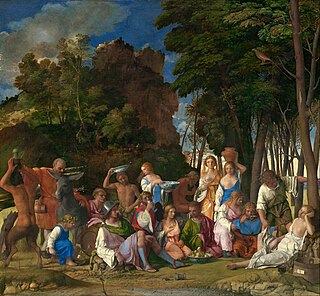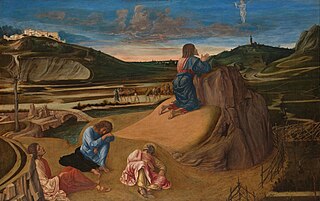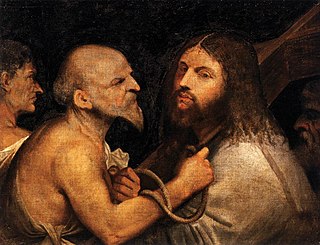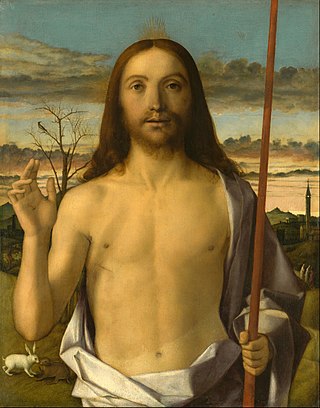Description
The painting shows the crucified Jesus, portrayed with a very pale skin, on a broad landscape background. The deep blue sky is populated by cherubim who are weeping at his death. In the lower part are Mary and St. John.
The background shows several details, including a lake with a wooden bridge, a quarry, small houses and a series of small working figures. Such a fragmented, detailed composition was typical of Jacopo Bellini, the artist's father, and was replaced by a more coherent one in Bellini's later works. Other elements typical of his early works are the rather crude painting strokes, the thin figures and the sharp lines.

Giovanni Bellini was an Italian Renaissance painter, probably the best known of the Bellini family of Venetian painters. He was raised in the household of Jacopo Bellini, formerly thought to have been his father, but now that familial generational relationship is questioned. An older brother, Gentile Bellini was more highly regarded than Giovanni during his lifetime, but the reverse is true today. His brother-in-law was Andrea Mantegna.

Gentile Bellini was an Italian painter of the school of Venice. He came from Venice's leading family of painters, and at least in the early part of his career was more highly regarded than his younger brother Giovanni Bellini, the reverse of the case today. From 1474 he was the official portrait artist for the Doges of Venice, and as well as his portraits he painted a number of very large subjects with multitudes of figures, especially for the Scuole Grandi of Venice, wealthy confraternities that were very important in Venetian patrician social life.

Jacopo Bellini was one of the founders of the Renaissance style of painting in Venice and northern Italy. His sons Gentile and Giovanni Bellini, and his son-in-law Andrea Mantegna, were also famous painters.

BartolomeoMontagna was an Italian Renaissance painter who mainly worked in Vicenza. He also produced works in Venice, Verona, and Padua. He is most famous for his many Madonnas and his works are known for their soft figures and depiction of eccentric marble architecture. He is considered to be heavily influenced by Giovanni Bellini, in whose workshop he might have worked around 1470. Benedetto Montagna, a productive engraver, was his son and pupil and active until about 1540. He was mentioned in Vasari's Lives as a student of Andrea Mantegna but this is widely contested by art historians.

Marco Basaiti was a Venetian painter of the Renaissance who worked mainly in Venice and was a contemporary of Giovanni Bellini and Cima da Conegliano. He has been referred to by several names including Marco Baxaiti, Marcus Basitus, and Marcus Baxiti. There is little documentation on Marco Basaiti besides his painting signatures and a guild's ledger of 1530 that records him as a painter of figures.

The Feast of the Gods is an oil painting by the Italian Renaissance master Giovanni Bellini, with substantial additions in stages to the left and center landscape by Dosso Dossi and Titian. It is one of the few mythological pictures by the Venetian artist. Completed in 1514, it was his last major work. It is now in the National Gallery of Art in Washington D.C., which calls it "one of the greatest Renaissance paintings in the United States".

The Agony in the Garden is an early painting by the Italian Renaissance master Giovanni Bellini, who created it ca.1459–1465. It is a tempera painting on panel and is now in the National Gallery, London.

Marco Marziale was a Venetian painter from, known to have been active from 1492/93 to 1507. He was a pupil of Giovanni Bellini, as stated in some of his inscriptions signing works, and was also influenced by Giovanni's brother Gentile, with possibly some elements of the style of Perugino also. From January 1493, when he must have at least completed his training, he was employed by the Republic of Venice as an assistant to Giovanni Bellini on the Great Council Chamber in the Doge's Palace at a fairly modest salary. These paintings were all lost in the great fire of 1574. In 1493 he joined the confraternity of the Scuola di San Marco.

Venetian painting was a major force in Italian Renaissance painting and beyond. Beginning with the work of Giovanni Bellini and his brother Gentile Bellini and their workshops, the major artists of the Venetian school included Giorgione, Titian, Tintoretto (1518–1594), Paolo Veronese (1528–1588) and Jacopo Bassano (1510–1592) and his sons. Considered to give primacy to colour over line, the tradition of the Venetian school contrasted with the Mannerism prevalent in the rest of Italy. The Venetian style exerted great influence upon the subsequent development of Western painting.

The San Zaccaria Altarpiece is a painting by the Italian Renaissance painter Giovanni Bellini, executed in 1505 and located in the church of San Zaccaria, Venice.

Christ Carrying the Cross is an oil painting attributed to either Titian or Giorgione. It is dated to about 1505. The painting is housed in the Scuola Grande di San Rocco in Venice, Italy. There are several later versions of the subject by Titian.

Saints Christopher, Jerome and Louis of Toulouse is an oil-on-panel painting by the Italian Renaissance artist Giovanni Bellini, executed in 1513, and housed in the church of San Giovanni Crisostomo, Venice.

The San Giobbe Altarpiece is a c. 1487 altarpiece in oils on panel by the Venetian Renaissance painter Giovanni Bellini. Inspired by a plague outbreak in 1485, this sacra conversazione painting is unique in that it was designed in situ with the surrounding architecture of the church, and was one of the largest sacra conversazione paintings at the time. Although it was originally located in the Church of San Giobbe, Venice, it is now in the Gallerie dell'Accademia in Venice after having been stolen by Napoleon Bonaparte.

The Madonna with Child, or Alzano Madonna, is an oil-on-panel painting by Italian Renaissance artist Giovanni Bellini, executed around 1485.

The Madonna of the Small Trees is an oil-on-panel painting by Italian Renaissance artist Giovanni Bellini, executed in 1487. It is housed in the Gallerie dell'Accademia in Venice.

St. Mark Preaching in Alexandria is an oil painting by the Italian Renaissance artists Gentile and Giovanni Bellini, dated to 1504–1507, and held in the Pinacoteca di Brera, in Milan.

St. Jerome in the Desert or St. Jerome Reading in the Desert is a 1480 oil-on-panel painting by the Italian Renaissance master Giovanni Bellini, now in the Uffizi Gallery in Florence as part of the Contini Bonacossi collection, giving it its alternative title of The Contini Bonacossi St. Jerome.

The Greek Madonna is a 1460–1470 tempera-on-panel painting by the Italian Renaissance artist Giovanni Bellini. It is named after the Greek monograms at top left and top right and after the major influence of Byzantine icons on the painting. The Christ Child holds a golden apple, perhaps referring to the Judgement of Paris and to Mary as the "new Venus".

The Madonna and Child with St. John the Baptist and a Female Saint or the Giovanelli Sacred Conversation is an oil painting on panel by the Italian Renaissance master Giovanni Bellini, dated to before 1504. It is kept in the Gallerie dell'Accademia of Venice.

Christ Blessing is a painting by Italian Renaissance master Giovanni Bellini created around the year 1500.




















